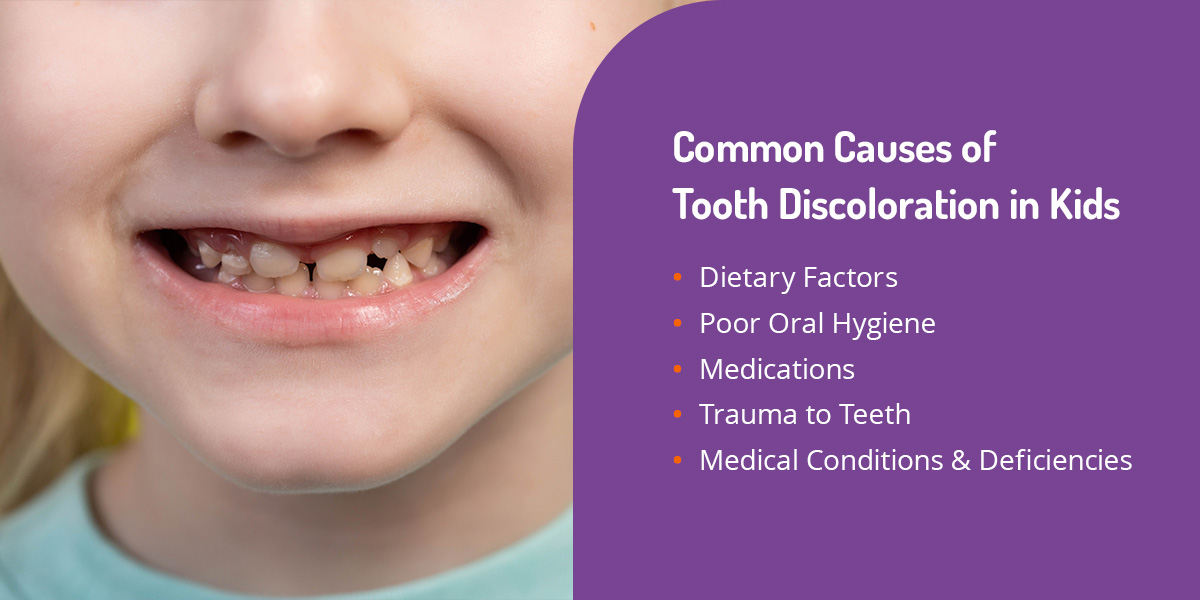As a parent, noticing a change in your child’s teeth can cause concern. It probably means that dental issues are cropping up. Naturally, you want to find the cause and treat the issue so your kid’s teeth can be their healthiest. If your child has a discolored baby tooth or your teen has a discolored permanent tooth, it’s time to see a dentist. But, first, you need to understand what is going on.
Understanding Tooth Discoloration
Tooth discoloration can occur in people of all ages for many reasons.
What Is Tooth Discoloration?
Tooth discoloration is the darkening or staining of the teeth, which can have various causes. Discoloration can affect any layer of the tooth. We see the affect on the enamel layer, or the surface of the tooth. You may wonder whether what you’ve noticed is true discoloration or superficial staining. Obvious signs of discoloration are when the tooth looks yellow or any other dark shade. Your kid’s teeth may also develop white spots or take on a dull shade of white.
Types of Tooth Discoloration
Two types of tooth discoloration affect children:
- Intrinsic discoloration: This discoloration originates from within the tooth itself. It affects the layer beneath the enamel and is usually challenging to reverse.
- Extrinsic discoloration: This occurs when external factors cause stains on the tooth’s surface.
Common Causes of Tooth Discoloration in Kids

Tooth discoloration has many causes. Some of them you can control, but others you can’t. Here are some common reasons why your kid’s teeth might be discolored:
1. Dietary Factors
Food and drinks are a common cause of discoloration, especially when they are acidic. The acid in certain foods and drinks, such as processed foods, citrus fruit juices and sugary drinks, weakens the enamel and opens up its pores. A weak enamel absorbs color from various foods and drinks and begins to discolor over time.
However, acidic foods and drinks are not the only cause. Sugar is the main culprit in your child’s diet. Harmful bacteria exist in the mouth, and they react with sugar to produce acid. The acids eat away the protective outer layer of the tooth in a process called demineralization. With weakened enamel, stains start to stick.
2. Poor Oral Hygiene
If your kid doesn’t brush their teeth properly, leftover food particles called plaque accumulate. Plaque contains bacteria that weaken the teeth, leading to discoloration.
3. Medications
Certain medications, including antihistamines and antibiotics like tetracycline, can cause tooth discoloration in children. Infant and toddler tooth discoloration may develop if your child takes iron medications, including supplemental vitamins. Also, you may want to discuss with your doctor before taking tetracycline and doxycycline antibiotics during pregnancy and when nursing as they may cause discolored baby teeth.
4. Trauma to Teeth
Your child may develop tooth discoloration due to trauma. Since their teeth are still forming, they are not as strong as an adult’s tooth. A fall may rupture blood vessels within the teeth resulting in internal bleeding that darkens the teeth.
5. Medical Conditions and Deficiencies
Children born with hyperbilirubinemia, a condition caused by excess bilirubin in the blood, may develop green or yellow baby teeth. Celiac disease, liver disease, calcium and vitamin D deficiencies, and metabolic diseases can also cause tooth discoloration.
Identifying Different Colors of Discoloration
Discoloration can occur in various colors and shades. If you notice a certain color, here’s what it may mean:
1. White Spots
White spots on your kid’s teeth can result from dental fluorosis, a common condition caused by high exposure to fluoride minerals during tooth development. Fluoride occurs naturally in water, but its levels vary depending on your region. Since the mineral can fight tooth decay, most toothpastes contain it. Fluoride is fine in small quantities, but in high quantities, it can lead to tooth discoloration in children.
A more serious reason for white spots on the teeth is chronic kidney failure.
2. Yellow and Brown Stains
Yellow and brown color may imply that your child doesn’t clean their teeth well, resulting in excessive staining. Staining generally comes from highly pigmented foods and drinks such as berries, red meat, soy sauce and soda. Alternatively, yellow and brown stains may result from iron supplements or antibiotics like chlorhexidine.
3. Gray or Black Discoloration
Certain antibiotics can also cause grayish or blackish discoloration. Another common reason is trauma, which causes blood vessels to rupture and teeth to bleed from within.
Prevention Strategies for Tooth Discoloration
Many discolorations can be permanent, so prevention is key. Try these strategies:
1. Good Oral Hygiene
The best prevention strategy for tooth discoloration is maintaining good oral hygiene. We regularly clean our teeth to remove food particles that cause plaque buildup. You may want to inform your kids that plaque contains bacteria that produce acid and harm teeth. Make sure they know how to brush and floss properly.
2. Dietary Adjustments
Try limiting foods and drinks that cause teeth stains. These generally have strong colors. Also, reduce sugary foods like candies from your child’s diet. Giving them sweet treats now and then is fine as long as you encourage them to rinse their mouths and drink water afterward.
3. Regular Dental Visits
Dentists are experts on teeth care and have various ways to address discolorations depending on the underlying cause. Since determining the reason behind discoloration requires professional analysis, it’s best to schedule a dental visit and let a pediatric specialist examine your child.
4. Trauma Prevention
Although it can be difficult, attempting to keep kids away from trauma to their teeth is a great way to limit tooth discoloration. For protruded teeth, orthodontics can sometimes help mitigate the chances of trauma. Mouth guards for impact sports can help protect the teeth and reduce the chances of impact to the dentition. Kids will be kids and trauma is often unavoidable, but attempting to take a few easy steps can help.
Addressing Existing Discoloration
The first method for addressing tooth discoloration is deep cleaning and gentle whitening. Your dentist may also suggest alternatives like dental bonding and porcelain veneers. With dental bonding, the dentist applies a composite resin that conceals discoloration. Alternatively, they may glue porcelain veneers to the tooth surface to mask permanent discoloration.
How Do You Fix Kids’ Stained Teeth?
Pediatric dentists consider dental bonding a safe option for kids, but they’ll generally take precautions with veneers since children’s teeth are still developing and veneers usually require removing a portion of the enamel layer. Whitening products are not fit for young children either. According to the American Academy of Pediatric Dentistry (AAPD), there isn’t sufficient research to declare teeth bleaching is safe for kids because whitening agents contain high concentrations of hydrogen peroxide, which harms non-permanent teeth.
You should also avoid over-the-counter whitening treatments. Popular home remedies, like baking soda, citric acid and activated charcoal, can also damage your child’s enamel. Before trying any of these methods, consult a pediatric dentist. Still, prevention is the best remedy for children.
Consult a Specialist at Fox Kids Dentistry & Orthodontics
If your child has tooth discoloration, it’s best to get them to a dentist soon. Discoloration may result from external factors but may also indicate an underlying issue. Early intervention may save your child’s teeth and improve their overall dental wellness in case of a serious problem.
Kids can learn healthy dental practices and awareness from a young age. Encourage them to come to you if they notice anything different about their teeth so you can get them an appointment with a specialist at Fox Kids Dentistry & Orthodontics. Pediatric dentists have up to three years of extra training in addition to regular dental school training. Learn more about our dental and orthodontic services for children!


